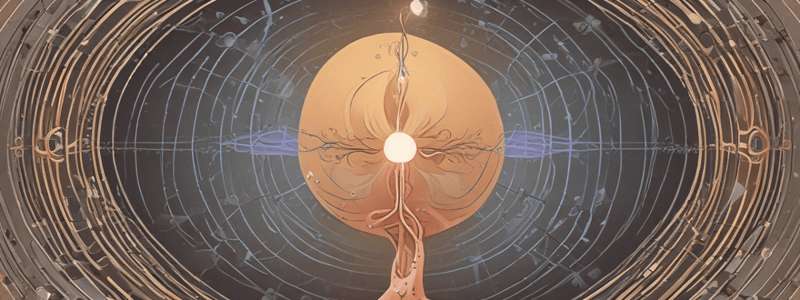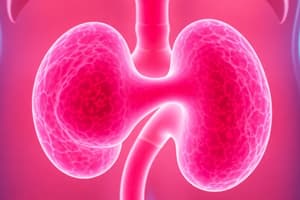Podcast
Questions and Answers
What is the purpose of irrigating the neobladder after surgery?
What is the purpose of irrigating the neobladder after surgery?
- To ensure the ureter opening is brought to the skin
- To maintain tissue integrity
- To make sure the pouch is patent (correct)
- To promote emotional well-being
What is the main concern for nursing care in the first weeks after surgery?
What is the main concern for nursing care in the first weeks after surgery?
- Extreme weight loss (correct)
- Social problems
- Tissue integrity and diet management
- Emotional and body image issues
What is the lining of transitional cells in the kidney, renal pelvis, ureters, urinary bladder, and urethra called?
What is the lining of transitional cells in the kidney, renal pelvis, ureters, urinary bladder, and urethra called?
- Urothelial cells
- Fibroblast growth factor receptors
- FGFR3 protein
- Urothelium (correct)
What is the purpose of BCG in intravesical chemotherapy?
What is the purpose of BCG in intravesical chemotherapy?
What type of conduit is created during surgery?
What type of conduit is created during surgery?
What is the primary symptom of urothelial cancer?
What is the primary symptom of urothelial cancer?
What is the function of the FGFR2 protein?
What is the function of the FGFR2 protein?
What is the role of the large intestine in creating a neobladder?
What is the role of the large intestine in creating a neobladder?
What is the purpose of cystoscopy with biopsy?
What is the purpose of cystoscopy with biopsy?
What is the purpose of a cystoscopy?
What is the purpose of a cystoscopy?
What is the term for the growth pattern of multifocal tumors in the bladder?
What is the term for the growth pattern of multifocal tumors in the bladder?
What is the significance of a functioning urethra in neobladder creation?
What is the significance of a functioning urethra in neobladder creation?
What is the main goal of tertiary prevention in bladder cancer?
What is the main goal of tertiary prevention in bladder cancer?
What is a risk factor for urothelial cancer?
What is a risk factor for urothelial cancer?
What is the purpose of genetic testing in secondary prevention?
What is the purpose of genetic testing in secondary prevention?
What is the reason for avoiding gas-producing foods in the diet after surgery?
What is the reason for avoiding gas-producing foods in the diet after surgery?
What is a primary prevention strategy for urothelial cancer?
What is a primary prevention strategy for urothelial cancer?
What is the benefit of low-grade urothelial cancer?
What is the benefit of low-grade urothelial cancer?
What is the primary goal of transurethral resection of bladder tumor?
What is the primary goal of transurethral resection of bladder tumor?
What is the benefit of using BCG in intravesical chemotherapy?
What is the benefit of using BCG in intravesical chemotherapy?
Why is it necessary to avoid gas-producing foods in the diet after surgery?
Why is it necessary to avoid gas-producing foods in the diet after surgery?
What is the role of the ureter opening in neobladder creation?
What is the role of the ureter opening in neobladder creation?
What is the purpose of maintaining tissue integrity in nursing care?
What is the purpose of maintaining tissue integrity in nursing care?
What is the purpose of cystoscopy in bladder cancer diagnosis?
What is the purpose of cystoscopy in bladder cancer diagnosis?
What is the benefit of neobladder creation?
What is the benefit of neobladder creation?
What is the primary goal of radiation therapy in bladder cancer treatment?
What is the primary goal of radiation therapy in bladder cancer treatment?
How often should the neobladder be emptied after surgery?
How often should the neobladder be emptied after surgery?
What is the main function of the FGFR3 gene?
What is the main function of the FGFR3 gene?
What is the characteristic of low-grade urothelial cancer?
What is the characteristic of low-grade urothelial cancer?
What is the primary test used for the definitive diagnosis of urothelial cancer?
What is the primary test used for the definitive diagnosis of urothelial cancer?
What is the risk factor for urothelial cancer represented by the letter 'C'?
What is the risk factor for urothelial cancer represented by the letter 'C'?
What is the term used to describe the lining of transitional cells in the kidney, renal pelvis, ureters, urinary bladder, and urethra?
What is the term used to describe the lining of transitional cells in the kidney, renal pelvis, ureters, urinary bladder, and urethra?
What is the benefit of smoking cessation in the prevention of urothelial cancer?
What is the benefit of smoking cessation in the prevention of urothelial cancer?
What is the characteristic of multifocal urothelial cancer in the bladder?
What is the characteristic of multifocal urothelial cancer in the bladder?
What is the purpose of genetic testing in the prevention of urothelial cancer?
What is the purpose of genetic testing in the prevention of urothelial cancer?
What is the first symptom of urothelial cancer?
What is the first symptom of urothelial cancer?
Flashcards are hidden until you start studying
Study Notes
Urothelial (Bladder) Cancer
- Malignant tumors of the urothelium, the lining of transitional cells in the kidney, renal pelvis, ureters, urinary bladder, and urethra.
- Also known as bladder cancer, as most of these cancers occur in the bladder.
Characteristics
- Low grade: less likely to grow, spread, and return after treatment.
- Multifocal in bladder: more than one tumor arising from one original tumor.
Risk Factors
- CEE S F:
- Chemical exposure (hair dyes, rubber, paints, etc.).
- Exposure to gas and diesel fuel.
- Excessive alcohol.
- Smoking.
- FGFR2 and FGFR3 genes.
FGFR2 and FGFR3 Genes
- FGFR2 protein: supports bone growth, particularly during development before birth (embryonic development).
- Signals certain immature cells in the developing embryo to become bone cells and form the head, hands, feet, and other tissues.
- FGFR3 gene: provides instructions for making fibroblast growth factor receptor 3 (protein).
Signs and Symptoms
- Painless hematuria: first symptom.
Primary Prevention
- SAR:
- Smoking cessation.
- Alcohol cessation.
- Reducing exposure to chemicals, gas, and diesel fuel.
Secondary Prevention
- Genetic testing.
- Cystoscopy with biopsy: definitive test.
- Cystoscopy: procedure to look inside the bladder using a thin camera called a cystoscope.
Tertiary Prevention
- Surgery:
- Can excise tumor.
- Types:
- Ileal Conduit: transurethral resection of bladder for small tumors.
- Involves Cystectomy: complete bladder removal.
- Creates Neobladder: continent reservoir; intestinal graft.
- Made from large intestines sewn together to form a pouch.
- Requires functioning urethra.
- Ureter opening brought to skin.
- Will have a drain.
- Irrigate to be sure it’s patent.
- Patient will not feel bladder fullness.
Nursing Care
- Concern over extreme weight loss first weeks after surgery.
- Maintain tissue integrity.
- Diet:
- Avoid gas-producing foods to prevent incontinence.
- How to use pouches, adhesives, and emptying (usually q 2-5 hrs.).
- Emotional, body image, sexual issues, and social problems.
Treatment Options
- Radiation therapy.
- Chemotherapy.
- Intravesical chemotherapy: first treatment.
- Bladder instillation of BCG (live virus compound).
- BCG: helps to stop or delay bladder cancers growing back or spreading into the deeper layers of the bladder.
Studying That Suits You
Use AI to generate personalized quizzes and flashcards to suit your learning preferences.




